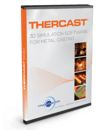 THERCAST® is available in an ALL-INCLUSIVE version including all the existing processes and features for simulating metal casting and solidification of your high-value cast parts.
THERCAST® is available in an ALL-INCLUSIVE version including all the existing processes and features for simulating metal casting and solidification of your high-value cast parts.
What's inside?
- Interface
- Process setup, results analysis - Materials
- Material database, material creation space, TTT diagram - Physical Analysis
- Metal front, fluid flow, turbulent flow
- Mechanical strength of the sand cores or inserts, elastic or plastic deformation of the pins, risks of wear, penetration phenomena, thermo-mechanical calculations
- Primary and secondary cooling, deformation in contact with rollers and spray-induced cooling, thermo-mechanical calculations, soft reduction effect, bulging defects, break out, tundish - Defect Prevention
- Hotspots, misruns and cold shuts, air entrapment, ghost lines, porosities, oxide entrainment
- Cracks, hot tearing, solidified thickness, air gaps, oxide entrainment, plastic deformations in hot parts of the mold, piercing
- Mechanical stresses and strains, residual stresses, surface shrinkage, internal shrinkage. - Interactions with the external Environment
- Self-radiation, temperature evolution on mold, mold warm-up, exothermic powder impact, interaction with the mold, coating, filters that impact shrinkage porosities, open shrinkage, liquid fraction zone and position of the liquid well, ghost lines in the mold - Metallurgy Analysis
- Micro/Macro segregations, grain growth and orientation
Dedicated templates
- Continuous Casting
- Sand casting
- Gravity die casting
- Low-pressure die casting
- High-pressure die casting
- Centrifugal casting
- Tilt casting
- Investment casting
- Bottom pouring for ingot casting
- Top pouring for ingot casting
- Tundish
Key advantages
- Solver
- Benefit from coupled of ‘fluid mechanics’ and ‘solid mechanics’ simulation
- Compute complete thermo-mechanical simulation for fine analysis - Foundry and Ingot Casting
- Take into account process parameters
- Model dynamic air gaps associated with solidification shrinkage
- Detect defects such as shrinkage, distribution of inclusions
- Take into account exothermic powder and its possible deformation
- Manage all interactions between the metal and the wall of the ingot mold, the slag and the mold flux
- Benefit from a shell creator and simulation of thermal behavior with coupled radiation to obtain accurate results
- Define all technological factors such as the presence of refractory materials or coating
- Benefit from the optimized feeder management
- Benefit from part- and mold-coupled thermo-mechanical resolution to anticipate mold deformation and breakage - Continuous Casting
- Take into account soft reduction to analyze the impact of pinch rollers on the cast product
- Perform calculation ‘by slice’ to reduce computation time
- Control the liquid fraction zone
- Anticipate solidified thickness in primary and secondary cooling areas
- Observe and analyze the causes of stress, damage and segregation
Would you like to receive information about other module offers?





